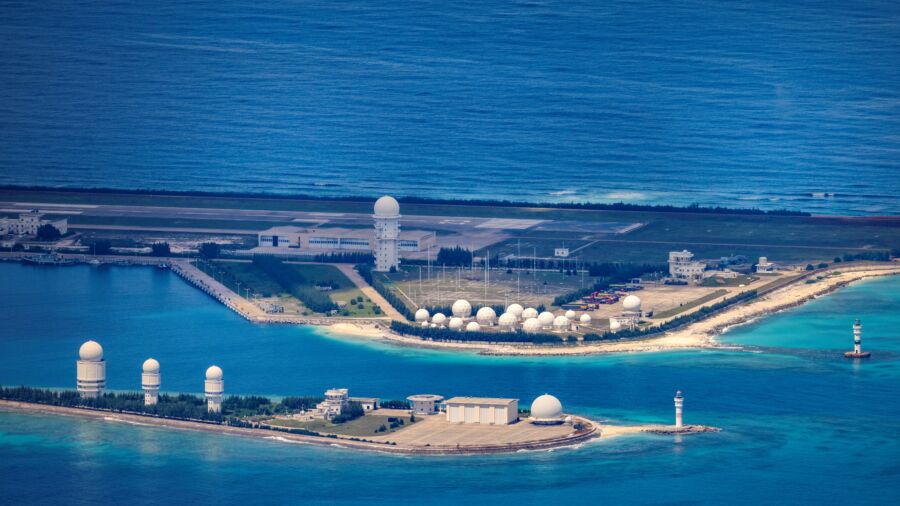At least six neighboring countries have objected to China’s new “standard” national map, which features a “10-dash line” instead of the previous nine dashes used to stake claims on the South China Sea.
The revised map, published by China’s Ministry of Natural Resources on Aug. 28, showcases China’s extensive claims in the disputed South China Sea, with an additional dash to the east of Taiwan.
It also includes the Indian state of Arunachal Pradesh and the Aksai Chin in the Himalayan border, which China controls but India also claims, as well as the Russian territory of Bolshoy Ussuriysky Island.
The day after the map was made public, the Indian government filed a strong protest against China through diplomatic channels and said that Beijing’s territorial claims were completely baseless.
“We reject these claims as they have no basis. Such steps by the Chinese side only complicate the resolution of the boundary question,” Indian Foreign Ministry spokesman Arindam Bagchi said in a statement.
Beijing published the map ahead of the G20 summit in India scheduled for Sept. 9–10. The Chinese Communist Party (CCP) has decided to send Chinese Premier Li Qiang in place of CCP leader Xi Jinping to the summit.
Malaysia’s Foreign Ministry also rejected China’s “unilateral maritime claims” and said that the new map encroached upon Malaysia’s claims in its states of Sabah and Sarawak.
“Malaysia does not recognize China’s claims in the South China Sea, as outlined in the ‘China Standard Map 2023 Edition’ which covers Malaysia’s maritime area,” the ministry stated.
“The map is in no way binding on Malaysia,” it added.
Malaysia said that territorial issues are “complex and sensitive” and should be resolved through dialogue in accordance with the 1982 United Nations Convention on the Law of the Sea (UNCLOS).
In Nepal, the government urged Beijing and other nations to respect the political map approved by its parliament in 2020.
The Tribune newspaper in India reported that China’s new map appears to recognize Limpiyadhura, Kalapani, and Lipulekh—which are all claimed by Nepal—as part of India.
“Nepal stands firm and clear on its political and administrative map unanimously approved by the Parliament of Nepal in 2020,” Nepal’s government said in a statement on Sept. 1.
Chinese Map Distorts Taiwan’s Sovereignty
Meanwhile, Taiwan affirmed that it is not a part of China and said that Beijing has never ruled the island.
“No matter how the Chinese government distorts its claims to Taiwan’s sovereignty, it cannot change the objective fact of our country’s existence,” Taiwanese Foreign Ministry spokesman Jeff Liu told reporters.
The CCP, which rules China as a one-party state, views Taiwan as a renegade province that must be united with the mainland by any means necessary, even though Taiwan has never been ruled by the CCP and has its own democratic government.
Vietnam’s Foreign Ministry spokesperson, Pham Thu Hang, said in a statement that China’s new map violated Vietnam’s sovereignty over the Paracel and Spratly Islands in the South China Sea.
“China’s sovereignty and maritime claims based on this dotted line, as showcased in the above map, are null and void. Such claims go against international law, particularly the UNCLOS 1982,” Ms. Pham stated.
The Philippines said the new map was an attempt by China to legitimize its purported sovereignty and jurisdiction over Philippine features and maritime zones in the South China Sea. It urged China to abide by the international law.
“The Philippines, therefore, calls on China to act responsibly and abide by its obligations under UNCLOS and the final and binding 2016 Arbitral Award,” the Philippines’ Foreign Affairs Department said.
In 2016, the Hague Tribunal sided with the Philippines in territorial disputes over the South China Sea, but China refused to recognize the ruling. Vietnam, Malaysia, Taiwan, and Brunei have also clashed with the CCP over its claims in the South China Sea.
China’s new map publication came just days after the Philippines announced plans for bilateral joint patrols with Australia in the South China Sea.
From The Epoch Times


